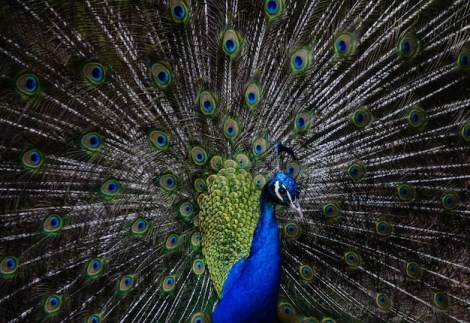Fascinating Facts about Peacocks

Peacocks are known for their strikingly beautiful and colorful feathers.
Did you know that peacocks are actually male while the females are called peahens?
Peacocks are native to South Asia, but they can now be found in many parts of the world due to human intervention.
The scientific name for peacock is Pavo cristatus.
Peacocks are known for their loud and distinctive calls, especially during mating season.
Peacocks are excellent flyers and can travel long distances.
In addition to their feathers, peacocks also have a distinct crest on their head.
The vibrant colors of a peacock’s plumage are believed to be an evolutionary trait to attract mates.
A peacock’s tail can be as long as 5 feet, making it one of the longest feathers in the bird kingdom.
Peacocks are omnivores, which means they eat both plants and small animals.
The sound a peacock makes is often referred to as a screech or a scream.
Peacocks have long been considered symbols of beauty, grace, and royalty in many cultures.
The iridescent feathers of a peacock can reflect a wide range of vibrant colors, including blues, greens, and purples.
Each peacock feather has a unique pattern, similar to a fingerprint in humans.
Contrary to popular belief, peacocks do not spread their feathers to attract rain but rather to attract a mate or intimidate rivals.
Peacocks are highly territorial and will aggressively defend their territory.
Fascinating Facts about Peacocks part 2
The mating display of a peacock involves the male spreading his feathers in a fan-like manner and vibrating them to create a rattling sound.
Peacock is the national bird of India.
Peacocks have been domesticated for centuries and were kept as pets by royalty.
The peacock’s display of feathers is known as a train.
Peacocks have excellent eyesight and can spot potential threats from afar.
The lifespan of a peacock is around 15-20 years in the wild.
Peacocks are adaptable birds and can survive in a variety of habitats, including forests, grasslands, and even urban areas.
The oldest known fossil of a peacock dates back to around 2 million years ago.
In Greek mythology, the eyes on a peacock’s feathers were believed to symbolize the stars.
Peacocks can sleep on trees, roofs, or any elevated place to protect themselves from predators.
Peacocks can make good watchdogs due to their loud calls, which can alert humans to potential danger.
The feathers of a peacock are not only beautiful but also serve as insulation to regulate body temperature.
Peacock feathers have been used as decorative items in many cultures, symbolizing beauty, wealth, and good luck.
Peacocks are relatively intelligent birds and can be trained to recognize patterns and perform simple tasks.
The male peacock is responsible for building a nest for the female during the mating season.
A group of peafowls is called a party or an ostentation.
Peacocks have been featured in many works of art throughout history, showcasing their majestic beauty.
The blue color of a peacock’s feathers comes from light reflecting off microscopic structures in the feathers.
Peacocks are known for their graceful and elegant movements, especially during courtship displays.
Peacock meat is considered a delicacy in some cultures, although it is not widely consumed.
Peacock feathers were used to make quill pens in ancient times.
In Hinduism, peacocks are considered sacred and are associated with deities such as Lord Krishna.
The diet of a peacock consists of fruits, seeds, insects, small mammals, and reptiles.
The mating season for peacocks typically begins in late winter or early spring.
A peacock can lose and regrow its feathers annually, usually after the mating season.
The train of a peacock can weigh up to 10% of the bird’s total body weight.
Peacocks have a keen sense of hearing, which helps them detect predators and find potential mates.
The courtship dance of a peacock is a mesmerizing display of beauty, with the feathers creating a stunning visual spectacle.
Peacocks are renowned for their ability to adapt and survive in various environmental conditions, making them a remarkable species in the animal kingdom.

